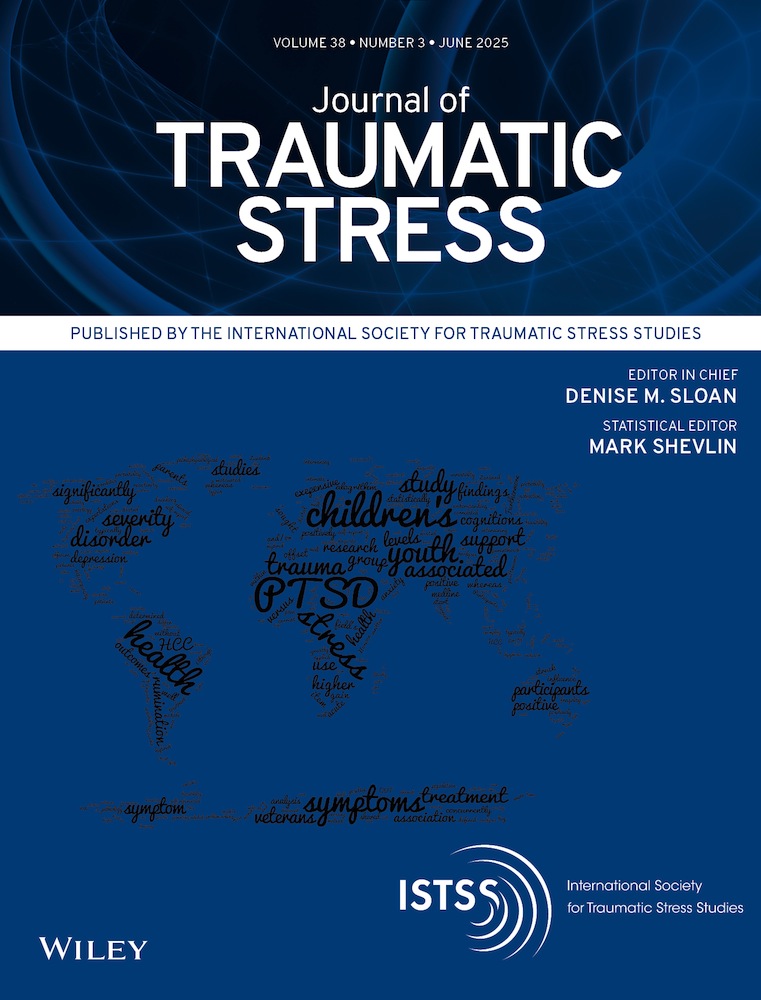Applications of dialectical behavior therapy to the treatment of complex trauma-related problems: When one case formulation does not fit all
Corresponding Author
Amy W. Wagner
Portland VA Medical Center, Portland, OR
Portland VA Medical Center, Box 1035, V3-SATP, Portland, OR 97207Search for more papers by this authorShireen L. Rizvi
Department of Psychology, New School for Social Research, New York, NY
Search for more papers by this authorMelanie S. Harned
Department of Psychology, University of Washington, Seattle, WA
Search for more papers by this authorCorresponding Author
Amy W. Wagner
Portland VA Medical Center, Portland, OR
Portland VA Medical Center, Box 1035, V3-SATP, Portland, OR 97207Search for more papers by this authorShireen L. Rizvi
Department of Psychology, New School for Social Research, New York, NY
Search for more papers by this authorMelanie S. Harned
Department of Psychology, University of Washington, Seattle, WA
Search for more papers by this authorAbstract
In this article, the authors take the perspective that effective treatment of complex trauma-related problems requires, in the absence of empirically supported treatments, a reliance on theory, idiographic assessment, and empirically supported principles of change. Dialectical behavior therapy (DBT; M. M. Linehan, 1993) is used to demonstrate the applicability of this approach to the treatment of multiproblem, heterogeneous populations in general. Two case studies are presented that highlight the utility of DBT principles to complex trauma-related problems specifically.
REFERENCES
- Beck, A. T., Ward, C. H., Mendelson, M., Mock, J., & Erbaugh, J. (1961). An inventory for measuring depression. Archives of General Psychiatry, 4, 561–571.
- Briere, J., & Spinazzola, J. (2005). Phenomenology and psychological assessment of complex posttraumatic states. Journal of Traumatic Stress, 18, 401–412.
- Davison, G. C. (2000). Stepped care: Doing more with less? Journal of Consulting and Clinical Psychology, 68, 580–585.
- Feeny, N. C., Zoellner, L. A., & Foa, E. B. (2002). Treatment outcome for chronic PTSD among female assault victims with borderline personality characteristics: A preliminary examination. Journal of Personality Disorders, 16, 30–40.
- First, M. B., Spitzer, R. L., Gibbon, M., & Williams, J. B. W. (1995). Structured Clinical Interview for Axis I DSM-IV Disorders–Client Edition (SCID-I/P). New York: Biometrics Research Department, NY State Psychiatric Institute.
- Foa, E. B., Dancu, C. V., Hembree, E. A., Jaycox, L. H., Meadows, E. A., & Street, G. P. (1999). A comparison of exposure therapy, stress inoculation training, and their combination for reducing posttraumatic stress disorder in female assault victims. Journal of Consulting and Clinical Psychology, 67, 194–200.
- Foa, E. B., Hembree, E. A., Cahill, S. P., Rauch, S. A. M., Riggs, D. S., Feeny, N. C., et al. (2005). Randomized trial of prolonged exposure for posttraumatic stress disorder with and without cognitive restructuring: Outcome at academic and community clinics. Journal of Consulting and Clinical Psychology, 73, 953–964.
- Foa, E. B., & Rothbaum, B. O. (1998). Treating the trauma of rape. New York: Guilford Press.
- Foa, E. B., Rothbaum, B. O., Riggs, D., & Murdock, T. (1991). Treatment of post-traumatic stress disorder in rape victims: A comparison between cognitive-behavioral procedures and counseling. Journal of Consulting and Clinical Psychology, 59, 715–723.
- Harned, M. S., & Linehan, M. M. (in press). Concurrent treatment of borderline personality disorder and PTSD using dialectical behavior therapy and modified prolonged exposure. Cognitive and Behavioral Practice.
- Hembree, E. A., Cahill, S. P., & Foa, E. B. (2004). Impact of personality disorders on treatment outcome for female assault survivors with chronic posttraumatic stress disorder. Journal of Personality Disorders, 18, 117–127.
- Linehan, M. M. (1993). Cognitive–behavioral treatment of borderline personality disorder. New York: Guilford Press.
-
Linehan, M. M., &
Schmidt, H., III.
(1995).
The dialectics of effective treatment of borderline personality disorder. In
W. T. O'Donohue &
L. Krasner (Eds.),
Theories of behavior therapy: Exploring behavior change
(pp. 553–584)
Washington, DC: American Psychological Association.
10.1037/10169-020 Google Scholar
- McDonagh, A., Friedman, M., McHugo, G., Ford, J., Sengupta, A., Mueser, K., et al. (2005). Randomized trial of cognitive-behavioral therapy for chronic posttraumatic stress disorder in adult female survivors of childhood sexual abuse. Journal of Consulting and Clinical Psychology, 73, 515–524.
- Rizvi, S. L., & Linehan, M. M. (2005). The treatment of maladaptive shame in borderline personality disorder: A pilot study of “opposite action.” Cognitive and Behavioral Practice, 12, 437–447.
- Salsman, N. L., & Linehan, M. M. (2006). Dialectical behavior therapy for borderline personality disorder. Primary Psychiatry, 113, 51–58.
- van der Kolk, B. A., & Courtois, C. A. (2005). Editorial comments: Complex developmental trauma. Journal of Traumatic Stress, 18, 385–388.
- Wagner, A. W., & Linehan, M. M. (1994). Relationship between childhood sexual abuse and topography of parasuicide among women with borderline personality disorder. Journal of Personality Disorders, 8(1), 1–9.
- Wagner, A. W., & Linehan, M. M. (2006). Applications of dialectical behavior therapy to PTSD and related problems. In V. M. Follette & J. I. Ruzek (Eds.), Cognitive–behavioral therapies for trauma (pp. 117–145) New York: Guilford Press.
- Weathers, F., Litz, B. T., Herman, D. S., Huska, J. A., & Keane, T. M. (1993, October). The PTSD Checklist (PCL): Reliability, validity, and diagnostic utility. Paper presented at the International Society for Traumatic Stress Studies, San Antonio, TX.
- Zanarini, M. C., Frankenburg, F. R., Marino, M. F., Reich, D. B., Haynes, M. C., & Gunderson, J. G. (1999). Violence in the lives of adult borderline patients. Journal of Nervous and Mental Disease, 187, 65–71.
- Zanarini, M. C., Frankenburg, F. R., Reich, B., Hennen, J., & Silk, K. R. (2005). Adult experiences of abuse reported by borderline patients and Axis II comparison subjects over six years of prospective follow-up. Journal of Nervous and Mental Disease, 193, 412–416.
- Zanarini, M. C., Williams, A. A., Lewis, R. E., Reich, R. B., Vera, S. C., Marino, M. F., Levin, A., Yong, L., & Frankenburg, F. R. (1997). Reported pathological childhood experiences associated with the development of borderline personality disorder. American Journal of Psychiatry, 154, 1101–1106.




